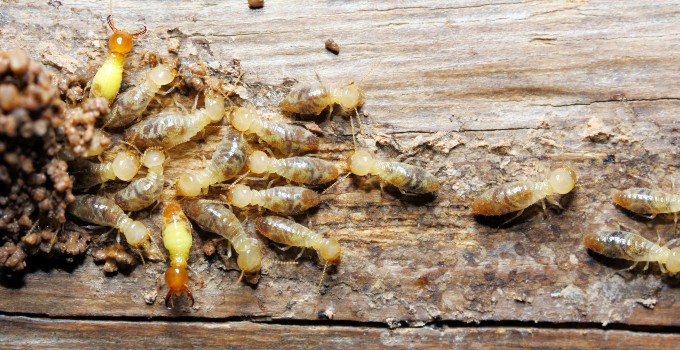
Like every homeowner and business owner in the U.S, damage-causing termites are a problem everyone must be mindful of. For Kansas residents, there are two types of termites most common to the state. These are the subterranean termites — eastern subterranean, dark southeastern subterranean, light southeastern subterranean, arid-land subterranean — that are native to the state, and the drywood termite that is not native to Kansas.
Subterranean Termites
Among the subterranean termite colony, there are soldiers, workers, and alates. Workers and soldiers are similar in appearance as neither has wings. Soldiers have a brown head and creamy-white body. As defenders of the nest, they have larger jaws than the other species. Workers are ivory colored and are small in size with an estimated length of a quarter-inch. The alates, which form the reproductive group, are between a quarter and a half-inch in length. Alates are darkish brown to black and have two pairs of wings.
Swarm time is different for each subterranean species. The eastern subterranean is usually most active from March to May during the daylight hours. The dark southeastern usually swarms between March and June also during the day. The light southeastern swarms during the daylight hours beginning in August and on to October. The arid-land subterranean likes both the spring and fall to swarm during the day.
Drywood Termites
Although not as prevalent as the subterranean termites, drywood termites are also found in Kansas. Drywood alates can be identified by the pattern on their front wings, which have several distinctive veins on the outer border of each wing. Soldier and worker drywood termites are larger than the subterranean species.
Signs of Termites in Kansas Homes
Subterranean termites are visible when the female and male winged reproductive termites leave the colony and swarm. These swarms are triggered by warm temperatures and excessive rainfall. The swarming agates have four wings of equal size, which helps identify them as termites versus flying ants that also have four wings, but their front wings are large, and the back wings are smaller. Once the agates have mated, wings are discarded creating small piles commonly found on windowsills.
Signs of drywood termites aren’t always easy to spot since the wood they are feeding on doubles as a space for their colony to live. They are hidden inside the wood, in tunnels, whether it is a door frame, walls, or a piece of furniture. It may take anywhere from five to seven years before signs of damage are visible and before a colony is noticed.
When drywood termites swarm, which may be once a year, occasionally two, the agates, also referred to as swarmers, or flying termites, can be spotted, the swarm is small, so it is easy to miss it. Discarded wings and paint that appears to be peeling or bubbling can be a sign of a drywood termite infestation. Another sign is tiny mounds of frass, which are termite droppings, near door frames or window sills.
Termite Professionals
When your home or business is under attack by termites, it’s time to call in our team of experts at Schendel Pest Services to eliminate the invading force. With years of experience to rely on, our technicians know how to quickly find, treat, and eliminate termites. Put your mind at ease and use our convenient online form to schedule an inspection.
What Types of Termites Are There in Kansas in Kansas, Missouri and Arizona
Serving Kansas, Missouri and Arizona






